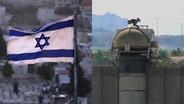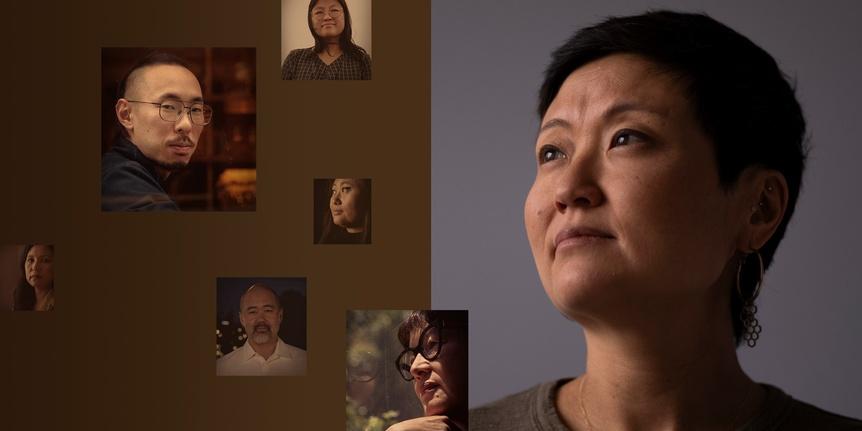>> NARRATOR: Now, a special presentation from the Middle East.
First... >> The conflict between Israel and Hamas may be expanding... >> NARRATOR: Amid fears of a widening conflict, correspondent Ramita Navai is on the ground in the West Bank.
>> All the homes here are covered in bullet marks.
Nearly every other day, IDF forces are coming here and clashing with militants.
>> People want to end the occupation that's why they support anybody who resists occupation.
>> So what do Israelis want right now?
>> Restoring security.
>> This is another front in Israel’s war.
>> NARRATOR: And later...
In collaboration with the Washington Post.
>> NARRATOR: Reporter Jon Swaine investigates how Hamas carried out their brutal attack.
>> They said this will protect the residents.
Was that a mistake to promise those things?
>> We really thought that we are building a very good infrastructure.
Unfortunately, it didn't work.
>> NARRATOR: These two stories on this special edition of FRONTLINE.
>> Fresh rounds of strikes have been launched at Gaza as Israel warns of a long and difficult war ahead... >> Now there are reports that the fighting has intensified, air strikes as well as ground fighting.
>> RAMITA NAVAI: I arrived in the region weeks after the October 7th Hamas attack, as fears were rising that the war in Gaza could spread.
>> Nothing untouched in the fury of Israel's hunt for Hamas.
Streets here crushed... >> NAVAI: Israel was launching operations against militants here in the Palestinian areas of the West Bank, which many were concerned could explode into a second front.
>> Israeli forces have continued their raids in the occupied West Bank, killing at least six Palestinians... ♪ ♪ >> NAVAI: I headed to Tulkarem, where there'd been recent clashes between Israeli forces and Palestinian fighters.
Before October 7, Hamas didn't have much of a presence in the West Bank, which is dominated by their bitter political rivals, the Palestinian Authority's Fatah Party.
I wanted to investigate how support for Hamas, and other militant groups, was changing.
♪ ♪ There was an Israeli raid here in Tulkarem yesterday.
Seven Palestinians were killed and we're about to join a funeral procession up ahead.
I was told the number of Hamas fighters here is small, but many of the young men in the crowd were armed.
(gunfire) They were members of the Tulkarem Brigade, one of the new locally based groups that have emerged in the West Bank over the last two years.
(gunfire) (crowd clamoring) In the procession they carried the bodies of two fighters who'd been killed the night before.
(crowd shouting) In a show of solidarity, they waved Hamas's green banner, and the dead fighters were wrapped in Hamas flags.
(gunfire in distance) After the funeral, some of the fighters from the Tulkarem Brigade agreed to talk to me, as long as we didn't identify them.
They spoke admiringly about Hamas's military strength.
>> (speaking Arabic): >> NAVAI: They said the war was galvanizing them.
>> (speaking Arabic): >> NAVAI: Can you tell me what's happening in terms of the differences between the armed groups since the October 7 attacks?
>> (speaking Arabic): >> NAVAI: One of the fighters, a 22 year-old called Mohammed, took us through the streets to show us where three men had been killed the day before.
He said they were civilians; the Israeli military said they were hurling explosives.
>> (speaking Arabic): >> (speaking Arabic): >> NAVAI: I wanted to find out what residents thought about the militants.
The streets had been torn up, the electricity and water lines cut by Israeli bulldozers, which the military says it uses to destroy explosives.
>> We have no water, we have no electricity.
What is their justification to damage the street?
♪ ♪ >> NAVAI: Abdulrahman Abdrabboh is an English teacher.
He told me that during their raids, Israeli forces routinely leave neighborhoods in ruins.
What do you think of the young men joining these new militias here?
>> For me, it is a reaction to the Israeli occupation and to the suffering we are undergoing every day.
If the Israeli violence against Palestinians continues, more and more people will join the violence.
♪ ♪ >> NAVAI: What I heard in Tulkarem was echoed across the West Bank-- land captured by Israel in the 1967 Arab-Israeli war.
It's still under Israeli military control but widely seen as the basis of a future Palestinian state.
It's now home to some two-and- a-half million Palestinians and half a million Israeli settlers.
Under the far right government of Benjamin Netanyahu the settlements have been expanding.
And adding to the tensions since Oct. 7, there have been hundreds of reported attacks by extremist settlers against Palestinians.
One incident that sparked outrage happened on October 11, in Qusrah.
(gunfire) Masked settlers entered the village and began shooting.
(gunfire) (camera person breathing heavily) Over several hours-- much of it captured on video-- four Palestinian residents were killed.
(gunfire continues) ♪ ♪ Abdel Hakim Wadi lives in Qusrah.
He says this video shows his brother and nephew being ambushed and killed by settlers the next day, as they took the four bodies for burial.
(sirens wailing, gunfire erupts) (man exclaiming) >> (speaking Arabic): (sobbing) >> NAVAI: The Israeli military, which has outposts less than half a mile away from Qusrah, have said they're investigating the killings.
♪ ♪ Ramallah, the headquarters of the Palestinian Authority.
The P.A.
governs over a third of the West Bank under interim agreements with Israel.
But since Oct. 7, Netanyahu has ruled out working with them towards establishing a Palestinian state.
And among Palestinians, the P.A.
has long been seen as ineffective and corrupt.
A recent poll in the West Bank shows increasing support for armed struggle.
Khalil Shikaki conducted that poll.
He's tracked Palestinian public opinion for decades.
>> The level of support for armed struggle in the West Bank before October the 7th stood at about 54 percent.
Today, it is almost 70 percent.
We've seen, therefore, about 14-, 15-percentage point increase.
The perception is that there is today, no political or diplomatic, uh, option available to Palestinians.
If Palestinians are unhappy with the status quo, the only way to change it is violence, armed struggle, formation of armed groups.
That is a fundamental reasoning that the overwhelming majority of the Palestinians today fully endorse.
>> NAVAI: While most Palestinians don't agree with Hamas's radical Islamist agenda, their support in the West Bank has also grown from 12 to 44 percent since October 7.
How can you square the increase in popularity for Hamas with the brutality of the October 7 attacks?
>> Those who saw the videos were ten times more likely to come to the conclusion that Hamas committed atrocities.
Ten times more likely than those who did not.
The majority of Palestinians today, however, does not buy into the Israeli narrative of what happened on October the 7th.
(man vocalizing) (indistinct chatter) >> NAVAI: As the death toll in Gaza has reached into the thousands, Friday prayers in Ramallah have often been followed by demonstrations.
(crowd chanting in Arabic): >> NAVAI: One of the chants here has been "You say Hamas are terrorists, we say the whole of the West Bank are Hamas."
And what's interesting is that there are lots of different political groups here, some secular, and they're all demonstrating side by side with Hamas supporters.
(crowd chanting in Arabic) (voiceover): On the fringes of the protest were the Palestinian Authority's security forces.
Hamas violently ousted the P.A.
from Gaza 16 years ago.
(chanting and clapping): A demonstration like this, chanting support for Hamas would never have happened before the October 7 attacks, because it would have been met by violence from the Palestinian Authority, and what's extraordinary is that they're letting this happen.
They're just standing by, because they know opinion here has changed... (chanting continues) ...and that tensions are so high.
(clapping and chanting): >> NAVAI: Mustafa Barghouti is an opposition politician who's been critical of the Palestinian Authority and its leader, President Mahmoud Abbas.
>> They're frightened by the fact that they are so weak and that the public is angry at them, because of their passivity and lack of initiative when their people are slaughtered in Gaza.
The Palestinian Authority was already weak, before the 7th of October.
They're mostly weak because Israel weakens them, because Israel humiliates them every time they invade cities that are supposed to be under the Palestinian Authority.
>> NAVAI: Support for Hamas is growing in the West Bank.
Why do you think that is?
>> You shouldn't mix between two things-- the support to Hamas and the support to the principle of resistance.
People want to end occupation and they want to have the right to resist occupation.
And that's why they support anybody who resists occupation.
>> NAVAI: I went to the Palestinian Authority's headquarters to meet with the president's spokesman, Nabil Abu Rudeineh.
He blamed the rising support for militant groups on Israel.
>> They are invading our country.
Since October the 7th, more than 280 Palestinians were killed in the West Bank.
280 Palestinians were killed.
Hundreds of houses were demolished.
If they are ready for peace, we are ready.
If they are not, things will change, and nobody will live peacefully.
And we keep saying, "Peace for everybody or no peace for anybody.
"Security for everybody, or no security for anybody."
>> NAVAI: He denied that Hamas is a threat to the P.A.
's authority.
Why do you think support for Hamas is growing here in the West Bank?
>> Don't, don't listen...
I know you have the right to ask any questions and I'm ready to answer it.
But I have to tell you, don't listen... to this, to many things around you here and there.
Once we have elections, elections will decide who has popularity or who doesn't have.
♪ ♪ >> NAVAI: Not far from the P.A.
headquarters, one night I attended a demonstration protesting the war in Gaza.
>> (chanting in Arabic): >> NAVAI: During the march, I met Afaf Ghatasha, a women's rights activist.
>> (speaking Arabic): >> NAVAI: Several days later, in late November, Israel and Hamas agreed to a temporary ceasefire.
One night, during that ceasefire, Hamas said it would release 24 of the estimated 240 hostages it was holding.
In exchange, Israel would release 39 Palestinian prisoners.
Just up there is Ofer Prison, where some of the prisoners are going to be released, and you can see that people have started to gather here.
And as you can see, loads of people here are holding up Hamas flags.
And just a hundred meters in front of them are Israeli soldiers who are at war with Hamas.
We climbed a hill overlooking the Israeli prison.
(clamoring, indistinct shouting) Suddenly, an Israeli drone dropped tear gas canisters.
We ran to the town below.
(shouting continues) (cannisters bursting, horn blaring) There was more tear gas, and live fire, which wounded several people.
(sirens wailing) The crowds are being dispersed, you can hear, by tear gas.
(horn blaring) It's... starting to feel it now.
(blaring continues, Navai catches breath) (distant shouting) Near Ramallah, a crowd waited to welcome the prisoners, who were women and teenagers.
(horns blaring) (indistinct cheering, whistling) When they arrived, they were paraded through the streets.
>> (chanting in Arabic): Hamas!
Hamas!
I traveled to Tel Aviv.
The public displays here are of the hundreds of people killed by Hamas on Oct. 7, and the hostages still being held in Gaza.
(knocking) I met a former Israeli ambassador to the U.S., Michael Oren.
>> Hello.
>> NAVAI (voiceover): He said Israelis see the ongoing military campaign in the West Bank as a matter of survival.
What's the rationale for the widespread Israeli military incursions in the West Bank?
>> Security.
Security.
We forget that in the months leading up to the events of October 7, Israel lost some 40 citizens and soldiers to Palestinian terrorist attacks.
And there were reports of very large-scale terrorist attacks that were planned within Israel proper, including Tel Aviv, that were thwarted.
We're sitting here in South Tel Aviv.
If you go up to my upstairs, uh, office and look out the eastern-facing window, you see Hebron.
That's how close we are.
We won't be in rocket range, we'll be in rifle range.
>> NAVAI: I asked him about the role of settler violence and the rising tensions in the West Bank.
>> And I want to be unequivocal about this.
This is unacceptable and, again, causes a strategic damage.
It's a danger to our security.
Again, it's... you cannot generalize about the settlers.
We're talking about close to 500,000 people.
The vast, vast majority are law abiding, do not support this violence.
But yes, there are elements there.
And they have, uh, support within the government.
>> NAVAI: Since October 7, the IDF has arrested thousands of Palestinians in the West Bank including around 1,300 they say are affiliated with Hamas.
But Palestinian sources say that many of those arrested aren't linked to any crimes.
I met a former senior intelligence officer who specialized in the Palestinian territories.
Orna Mizrahi said Hamas and other militants aren't just a threat to Israel, but to the Palestinians, too.
>> Hamas groups, militant groups, terrorists, as we see them, they want the collapse of the P.A., the collapse of the more moderate Palestinian, uh, leadership in the, in the West Bank.
This is what their goal was, and this is what the IDF is fighting against.
>> NAVAI: But many civilians are being killed in these incursions.
>> There is not intention in doing it, but it happens-- sometimes it happens.
And I tell you, as one who is coming from the army, that there was... there is a big effort to prevent these accidents, but sometimes they happen.
♪ ♪ >> NAVAI: In the West Bank, the IDF have repeatedly targeted the Jenin refugee camp looking for wanted militants.
Walking around, there are so many houses that have been destroyed by rocket and drone attacks.
(dog barking) Hamas fighters have largely stayed in hiding here, but one of them agreed to talk to me.
We've just been told that a member of the Al Qassam brigade-- that's Hamas's military wing-- is prepared to meet us and people here are saying that's really unusual.
(indistinct talking) The man tells me he's helped lead Hamas's recruitment efforts in Jenin.
>> (speaking Arabic): >> NAVAI: He said his men were biding their time, and gave a veiled warning to the Palestinian Authority.
>> (speaking Arabic): (singing over loudspeaker) ♪ ♪ >> NAVAI: While I was in Jenin, Israeli forces launched another raid.
(horn honking) (raid sirens blaring) The Israeli forces are coming, there's going to be a raid.
(car horns blaring) We gotta run now.
(voiceover): The streets emptied.
(raid sirens blaring) (distant explosions) (gunfire) (explosion) I can see a column of bulldozers and they're working their way to the refugee camp.
(distant gunshots) There's thick smoke all around us, and that's tires burning that's stopping the drones from being able to see what's going on down here.
(gunshots continue) (rumbling, gasping) (birds chirping) In the morning, we went to investigate.
(gunshots) The fighting hadn't stopped.
We were at the camp entrance, and then gun fire started.
The Israeli military said it killed two high-ranking terrorists in the operation.
Two boys, a 15-year-old and an eight-year-old, were also killed.
Two months later, in January, I returned to the West Bank, amid a new wave of violence and major IDF operations.
>> Fears of a regional war in the Middle East are growing after... >> NAVAI: Tensions across the region were reaching new heights.
>> ...killed in an explosion in the Lebanese capital... >> NAVAI: A Hamas leader with ties to the West Bank was assassinated in Lebanon, sparking protests and violence.
Clashes with Hezbollah militants backed by Iran had led thousands of Israelis to evacuate from the north.
>> Evacuations in the wake of the October 7... >> NAVAI: While Houthi rebels in Yemen fired missiles to protest the war in Gaza.
>> A punishing series of U.S. and British strikes the first sign of retaliation.
>> NAVAI: Back in Tulkarem, I found Mohammed, the fighter who'd showed me around.
>> (speaking Arabic): >> NAVAI: He told me one of the other fighters I'd met had recently been killed by an Israeli drone.
>> (speaking Arabic): >> NAVAI: It was his brother.
Two days later, Mohammed was also killed.
♪ ♪ In Jerusalem, I went to see Sari Nusseibeh, a well-known Palestinian scholar and philosopher.
How critical is the point we've now reached?
>> Critical-- it's, uh, I hope it's, we've passed the critical stage between the Israelis and Palestinians with the war that's raging in Gaza.
And I hope that after this, you know, uh, the world will open its eyes to the need to step in and do something here.
If it doesn't, you know, if there's no solution, if there's no solution to the conflict, I think it'll just get worse in time.
You never know how a situation of war can actually drive people to act.
Things are boiling, simmering.
And I think, you know, the wise thing to do for everybody concerned, local and international players, is to try and contain this before it explodes.
♪ ♪ >> NARRATOR: Coming up next, a special visual investigation with "The Washington Post..." >> And some of the earliest rockets came over just around here.
>> NARRATOR: Reporter Jon Swaine on how Hamas breached Israel’s vaunted security barrier... >> What do you think October 7th says about the integrity of that barrier?
>> I think the question is not necessarily what is the barrier, but what was the threat assessment?
>> NARRATOR: “Failure at the Fence” starts right now.
(rockets pounding in distance) ♪ ♪ (people talking in background) >> More than 20 years, we are suffering from rockets here.
>> SWAINE: Before October 7, had anyone intruded?
Had they come into the kibbutz, or was that the first day that, that people... >> This is the first time.
>> SWAINE: Yeah.
(voiceover): I met Israel Lender in Kfar Aza, near the border with Gaza, in the weeks after the Hamas massacre that left around 60 of his neighbors dead.
>> This is my house.
You see now they covered all the glasses was broken.
From here, they can see all the streets.
>> SWAINE: So they came here, they went on your roof.
>> Yes.
>> SWAINE: So they could have a view of the rest of the kibbutz.
>> Yes, yes, yes.
>> SWAINE (voiceover): He told me Hamas gunmen stormed his house shortly after sunrise and turned it into a sniper's nest.
He hid with his wife in a nearby room for 36 hours.
>> The door was closed, the windows was closed, and the glass was open.
So I could hear everything.
(distorted speech and gunfire) (people shouting, radios beeping) (people shouting) >> (speaking Arabic) >> (screaming) (distant explosion echoing) >> Terrible.
You can't, you can't, you can't, uh, think about it.
♪ ♪ You can't believe it.
>> SWAINE: Mm.
>> You can't believe it.
You can't imagine it.
What they did here... >> SWAINE: Mm.
>> ...nobody can do.
They build a big wall.
>> SWAINE: Do you... Mm-hmm.
>> They said to us, 40, 40 meters in the ground, with the sensors that nobody can-- and six meter up.
>> SWAINE: They said, "This will protect you."
>> Yeah.
We believe that, that this can protect us.
>> SWAINE: They just broke through.
They came through.
>> They came through.
♪ ♪ >> (speaking Arabic): >> SWAINE: On the morning of October 7, more than a thousand fighters from the Palestinian militant group Hamas broke through the 20-foot-high barrier that has long separated Israel from the Gaza Strip, a densely populated enclave that is home to more than two million people.
The 40-mile-long barrier is outfitted with cutting-edge surveillance tools, a deep underground concrete layer to block Hamas tunnels, and remote-control machine guns above ground.
After a billion-dollar upgrade in 2021, Israeli officials dubbed it "the Iron Wall."
>> (speaking Hebrew): (explosion pounds) >> SWAINE: But in a matter of minutes, Hamas was able to breach the fence in around 30 locations-- the start of what would become the deadliest single assault in Israel's history.
Around 1,200 people were killed, 240 taken hostage.
♪ ♪ The attack triggered a catastrophic war in Gaza that has killed thousands of Palestinians so far.
Israel has vowed to destroy Hamas, which has controlled the territory for years.
>> Broadly, the fighters entered at 6:40 a.m. >> SWAINE: Uh-huh.
And that's the same incident, just from the other side of the street.
>> Exactly.
>> SWAINE (voiceover): Soon after the October 7 attack, "The Washington Post" began investigating how the so-called Iron Wall could have failed so spectacularly.
Our team of reporters analyzed hundreds of videos, photos, and audio recordings from before, during, and after the attack.
With "Frontline," we spoke with witnesses on the ground.
>> We got hit with the first RPG.
>> SWAINE: We examined maps and planning documents recovered from Hamas fighters.
We took the visual evidence from October 7 and mapped it across Southern Israel and inside the Gaza Strip, sometimes using the position of the sun to estimate when key events occurred.
What we found was a fragile barrier that gave Israel a false sense of security, leaving it blind to its own vulnerabilities and to the meticulous plan taking shape on the other side of the fence.
(people calling in background) >> SWAINE: The attack began at dawn, around 6:15 a.m.
Videos recovered from Hamas fighters show them setting off from Gaza and heading towards the fence, which has long been resented by Gazans who've been penned in by it.
(people shouting in Arabic) People along the road cheered them on.
(car horns honking) (people shouting in Arabic) Around 6:30, as fighters made their way to the fence, Hamas began firing a barrage of thousands of rockets at targets across the barrier.
♪ ♪ In just the first five minutes of the attack, there were red alerts from more than 30 communities near the Israeli side of the wall.
In Kibbutz Erez, less than a mile from the barrier, Ben Sadan, a member of the community security, had just woken up for an early morning bike ride.
>> (speaking Hebrew): >> SWAINE: So over there, we can see Gaza.
>> (speaking English): There.
>> SWAINE: Yeah.
And the, the security fence... >> Yeah.
>> SWAINE: You can see it running along there, and there's the towers with the machine gun.
>> Yeah, there, there's the border.
>> SWAINE: Yeah.
>> On the, on the left side, it's Gaza.
On the right side, (speaking Hebrew) Israeli.
>> SWAINE: And I think some of the earliest rockets came over just around here.
>> All around, all around.
>> SWAINE: Yeah.
>> (speaking Hebrew): >> SWAINE (voiceover): From this hilltop, the next wave of Hamas's attack became visible.
Reconnaissance fighters on paragliders, soaring over the wall under cover from the rockets.
Videos we obtained show them landing in communities inside Israel, the culmination of a plan that had been years in the making-- and that, as we discovered, had been brewing in plain sight.
>> When I first saw this video, I was, like, "Oh, this is video from the day of."
Like, "How did they get this produced out so quickly?"
And then, once you look closer, go... (clicks tongue): It's obviously a training video.
♪ ♪ >> SWAINE (voiceover): Our investigation found multiple videos recorded by Hamas detailing their planning measures.
Some were posted on social media before the attack, visible to all.
We found videos of militants training for attacks on mock-ups of Israeli compounds.
Videos posted soon after the attack showed they had also been practicing the use of paragliders.
Hamas had also been expanding their training camps, activity that was visible in widely available online maps.
But this evidence was largely ignored or dismissed by Israeli intelligence and the military, our investigation found.
♪ ♪ Michael Milshtein is a former head of the Palestinian department for Israel's military intelligence.
He has been strongly critical of their missteps leading up to October 7.
>> Israel knew about, about the whole plans, because, you know, Hamas didn't hide them.
It was on, on public, on their internet sites, on their TV-- everywhere.
From the operational tactic point of view, October the 7th, we, we-- Israel, IDF didn't, uh, face any, any surprise over there.
>> SWAINE: Were there specific warnings that something like this could be coming?
>> Well, according the reports in the Israeli media, there was very focused reports about the whole plan, the whole, the whole offensive plan, that promoted, and actually, the data, the reports itself, were known, even to senior ranks, senior figures in IDF intelligence.
But the basic assumption, the basic assessment, in, in the intelligence was that those are only trainings or a theoretic, theoretic attempts, but we are not speaking about something which is very feasible.
♪ ♪ >> (speaking Arabic in video) (panting in video) >> SWAINE (voiceover): The heart of Hamas's operation on October 7 was the stage that their videos call "the blinding plan," aimed at severing the connections to Israel's surveillance and security system.
♪ ♪ Israel uses seven Skystar surveillance balloons to monitor hotspots along the Gaza fence.
The balloons carry a long-range 360-degree camera.
But the model of camera that Israel uses on the balloons is relatively old and is no longer made.
On the morning of October 7, we found that three of the seven balloons were in need of maintenance and out of service.
(people talking in background, weapons firing in distance) Video from the attack shows one of the remaining balloons.
We were told it had been cut loose by the militants.
The balloons are part of a system that includes surveillance and weapons towers.
Visuals and other data from the towers are fed into monitoring centers inside Israel, including one near Re'im.
>> It doesn't matter how many combat soldiers they are.
If they don't know where the enemy is, they can't fight the enemy.
>> SWAINE: Rotem Horowitz spent two years monitoring the camera feeds at Re'im before completing her military service last spring.
Three of the balloons were out of service on the day, they weren't working.
>> Mm-hmm.
>> SWAINE: The cameras needed to be repaired, but they're old and out of production.
>> Yeah.
So... >> SWAINE: Is that a big problem?
>> I personally think it is.
They were first brought into use in 2006, and ever since then, it's kind of been the same system.
I mean, it doesn't work very well during rough weather, like, only when weather conditions are perfect.
>> SWAINE: Do you remember people sending up warnings that, you know, these balloons are getting out of date, some of them aren't working, they're not working in bad weather?
>> Yeah, I know that the surveillance operators on the balloon have... As long as I've been there-- you know, I served there-- we've been complaining about how the balloons see and, like, in general, their quality.
>> SWAINE: Mm.
>> Ever since I can remember.
>> SWAINE (voiceover): The balloons are supplemented by surveillance towers containing HD cameras, laser and infrared sensors, and radar, and can see people for almost six miles away, according to the manufacturer.
Other structures, called Sentry Tech towers, are topped with Samson weapons stations, which feature machine guns and sensors.
They're positioned every few hundred yards along the barrier and outside key military facilities, and are nicknamed Roeh-Yoreh, Hebrew for "sees fires."
Once the sensors send an intruder alert, IDF personnel can fire the 50-caliber machine guns by remote control.
>> We have to really make sure that we can firmly see a weapon and a threat before we can actually do anything with it.
So usually, like, if someone's getting close to the fence, we use it to kind of... Not shoot at them, but shoot near them to kind of, like, scare them away.
Like, "Don't come close."
You know?
We're not going to touch them if they don't come close.
The moment they're showing that they're a threat and they're coming close, that's when we start to act.
>> (speaking Hebrew): >> SWAINE: Video from one of the sentry towers on October 7 shows it firing on a group of Hamas fighters as they approach the fence near Kissufim.
But that's not what happened elsewhere.
Hamas fighters had come prepared to evade the towers, and documents recovered after the attack reveal a deep and detailed knowledge of Israeli defenses.
In this one, they specifically note the locations of surveillance systems.
Fighters also carried with them open-source satellite imagery annotated with coded locations of key structures along the wall.
Armed with this information, Hamas carried out their blinding plan using unmanned drones equipped with cameras to drop explosives on installations like this surveillance tower near the community of Be'eri.
Of the Sentry Tech towers marked on the map, we verified videos of at least two of them being attacked.
This one, located near Kfar Aza, was attacked twice by Hamas drones.
Incendiary explosive devices with fuses were dropped on the camera and weapons system.
Some of the training videos we found posted online show that these drone maneuvers had been well-rehearsed.
♪ ♪ Other videos from the 7th show towers being attacked with rocket-propelled grenades and gunfire.
It's hard to tell just from the video evidence how badly damaged the installations were.
Hi, thank you so much for your time.
I really appreciate you coming and seeing us tonight... (voiceover): But retired Colonel Dany Tirza, the former head of the Israeli military's fence administration, told me Hamas's blinding plan drastically undermined Israel's ability to respond to the attack.
>> That was a real, a real failure, because they succeeded to cut the command system.
The command system of all this area... >> SWAINE: Mm-hmm.
>> ...was built on one control system, and they succeeded to cut it.
And therefore, we couldn't use helicopters, because according to the Israeli system, the helicopters cannot shoot if there is no someone on the ground that show them where are your forces, where are the other, uh, side forces.
So they came, but they couldn't shoot, because they didn't know who and what is going on there.
>> SWAINE: In 2021, when the latest upgrade was unveiled, some of the political and military leaders made very firm, quite bold, claims for the barrier.
They said, "This will protect "the residents in the South.
Hamas will not get in."
And... Was that a mistake, to, to promise those things?
>> Of course it was a mistake.
We really thought that we are building a very good infrastructure that will help to save the lives of the Israelis.
Unfortunately, it didn't work.
>> SWAINE: He said the attack exposed a fundamental misconception about the fence.
>> It was built against people that will try to cross it.
It wasn't built against army or against a lot of people that are coming in one time.
>> SWAINE: Were you surprised-- you, personally-- surprised at how quickly they were able to blast through and, and make it into the bases and, and beyond?
>> I myself was not surprised that they cross it so quickly, because the fence is not built for such fighting.
It was built for another thing.
If you want to stop an army, you are doing it with army tools.
If you want to stop one, two, three terrorists, you're doing it with soft tools, like what we did.
We didn't thought that there will come a terror army from the other side that were crossing at the same time, big groups, and we were not prepared for that.
♪ ♪ >> SWAINE (voiceover): The Israeli government says Hamas broke through the fence in around 30 locations.
We obtained videos from 14 of them.
♪ ♪ The videos show trained Hamas fighters using explosives and munitions to blow holes in the fence and its concrete barriers.
(people yelling in background) ♪ ♪ It took them only minutes.
♪ ♪ By around 6:40 a.m., Israel's Iron Wall had largely crumbled.
♪ ♪ ♪ ♪ In the weeks that have followed, Israel's military and intelligence establishments have come under intense criticism.
A spokesman for the Israeli Defense Forces, Lieutenant Colonel Peter Lerner, agreed to speak with me at a military base in Tel Aviv.
Hamas has published several training videos which appear to show fighters in the months before practicing specific tactics that were then used on the day: blowing up fences, paragliding, and so on.
Did Israel not see this?
>> I mean, we're looking at what exactly transpired before the 7th of October, and there will be a time when the IDF will be doing that soul-searching that is required, and the IDF will review that, and those that need to take responsibility will have to take responsibility.
>> SWAINE: What do you think October 7 says about the integrity of that barrier?
>> So, the barrier itself is a concept that was perceived to be a strong line of defense.
But any line of defense can only withhold a certain amount of pressure.
And I think the question is not necessarily what is the barrier, but what was the threat assessment.
And these are the types of questions that we will be asking.
These are the types of questions that the, the answers to the residents of those towns, of the kibbutzim, we owe them, um, clarification, and, and, you know, accountability for the failure of not the fence, but the whole concept of operations.
And this, I think, is what the IDF will be looking into when we, when, when the war is over.
♪ ♪ (people speaking in video) >> SWAINE (voiceover): The Hamas fighters that broke through the fence that morning were bound for the military bases and communities along the border.
(firing) ♪ ♪ One group headed for Kibbutz Erez, where Ben Sadan and the rest of his security team had already armed themselves.
And watched with dismay as the fighters kept coming.
>> (speaking Hebrew): >> SWAINE: And they're carrying weapons?
>> (speaking Hebrew): >> SWAINE: What kinds of things are they carrying?
>> Um... AK-47, RPG, grenade... (speaking Hebrew): >> SWAINE: How many of them were there?
How many of your men were there?
>> (speaking Hebrew): ♪ ♪ >> SWAINE (voiceover): He told me the combat lasted three hours.
(on camera): After these few hours of fighting, what happened next?
>> (speaking Hebrew): ♪ ♪ >> SWAINE: Sadan and his team had avoided the potential massacre.
>> Breaking news out of Israel... >> Chaos erupting in Israel... >> SWAINE: But other communities were overrun.
>> Hamas militants currently attacking citizens... >> Shooting at people on the streets, attacking troops... >> SWAINE: At 7:01, the first Hamas gunmen broke through the gate at Kfar Aza.
>> We are in Kibbutz Kfar Aza.
>> SWAINE: More than 250 others would follow throughout the morning.
>> You can see this massacre.
It smells of death here.
♪ ♪ >> SWAINE (voiceover): Some of the fighters wore body cameras, and the videos recovered later show the rampage through the kibbutz.
>> (speaking Arabic) (weapons firing in distance, people talking in background) ♪ ♪ >> So this is my place.
>> SWAINE: Yeah.
>> What's left of my house.
>> SWAINE: Yeah, sure.
>> I don't have a roof, and look, everything is black and... >> SWAINE: Soot.
>> ...and burned.
>> SWAINE (voiceover): Yuri Levin witnessed the violence that day, and told me he'd barely escaped being kidnapped and taken to Gaza-- a fate that befell many of his neighbors.
>> He is kidnap, he is also kidnap.
>> SWAINE: And these are all friends of yours?
You knew everyone.
>> They kid, they kidnapped.
>> She kidnapped.
He is murdered.
He is also kidnapped.
Murdered, and two of them kidnapped, I think.
>> SWAINE: Yeah.
>> Yes, not I think-- I know.
And...
This is friends of me.
>> SWAINE (voiceover): Across the street, a group of his friends were returning home for the first time since the attack.
(Levin crying, heart beating) (crying, heartbeat continue) (Levin sniffles) >> (whispers) >> LEVIN (speaking Hebrew): >> INBUR: >> ADI: >> INBUR: >> INBUR and ADI: >> INBUR: >> NAOMI: ♪ ♪ >> SWAINE: Israel, can you tell me about who these people are in the pictures?
>> These pictures?
>> SWAINE: Mm.
>> This is our village team.
Football team.
They called, uh, the fox of the village.
>> SWAINE: The, the young men.
>> The Kfar Aza village.
Some of them die.
>> SWAINE: Show me.
>> Some of them, uh, are kidnap.
He's died.
And...
This is in Gaza.
Uh...
This, two brothers is in Gaza.
His parents' house?
>> SWAINE: Gone.
>> Was destroyed.
He's lost his mother and father, and his brother.
You know, almost everyone has a connection for who's murdered, who's kidnap, who's injured.
Everyone from here.
>> SWAINE: It's touched the whole community.
>> Yeah.
♪ ♪ >> Go to pbs.org/frontline for a Q&A with Ramita Navai.
>> ...and the tension is so high.
>> And for more of our films and reporting on the Israel-Hamas war.
>> With all of this death and destruction, it’s hard not to look back and say, where did the road turn?
>> Connect with FRONTLINE on Facebook, Instagram and X, formerly Twitter, and stream anytime on the PBS app, Youtube or pbs.org/frontline.
>> For more on this and other FRONTLINE programs visit our website at PBS.org/FRONTLINE.
FRONTLINE's "Israel's Second Front" and "Failure at the Fence" are available on Amazon Prime Video.









